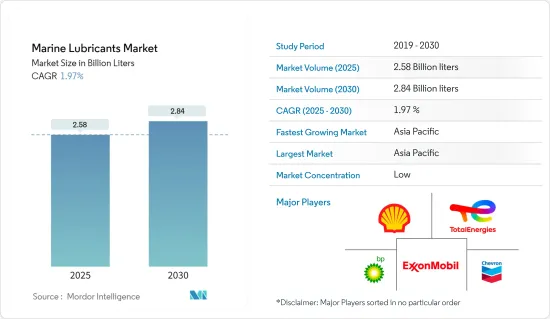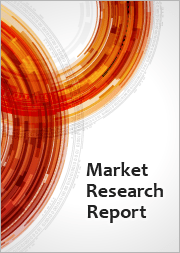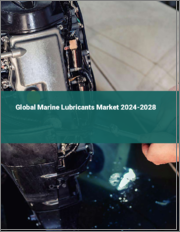
|
시장보고서
상품코드
1687311
세계의 선박용 윤활유 시장 : 점유율 분석, 산업 동향 및 통계, 성장 예측(2025-2030년)Marine Lubricants - Market Share Analysis, Industry Trends & Statistics, Growth Forecasts (2025 - 2030) |
||||||
세계의 선박용 윤활유 시장 규모는 2025년 25억 8,000만 리터로 예측되며, 예측 기간 중(2025-2030년) CAGR 1.97%로 확대되어, 2030년에는 28억 4,000만 리터에 달할 것으로 예측됩니다.

선박용 윤활유 시장은 COVID-19의 대유행에 의해 큰 과제에 직면했습니다.
주요 하이라이트
- 단기적으로는 해상 수송 수요 증가와 조선 활동의 활성화가 조사 대상 시장 수요를 견인합니다.
- 그러나 합성 윤활유와 바이오 윤활유의 개발과 엄격한 환경 규제가 시장의 성장을 방해할 것으로 예상됩니다.
- 그러나 각국의 해군력 확대는 시장에 새로운 기회를 가져올 것으로 예상됩니다.
- 아시아태평양은 중국과 인도에서의 수요가 가장 많아 세계 시장을 선도할 것으로 예상됩니다.
선박용 윤활유 시장 동향
선박용 실린더 윤활유 부문이 시장을 독점할 전망
- 선박용 실린더 윤활제는 선박의 원활한 운항, 특히 2스트로크와 4스트로크 디젤 엔진의 윤활에 필수적입니다.
- 실린더 라이너에 보호막을 형성하는 것으로, 선박용 실린더 윤활제는 마모나 부식을 막아 찰과상이나 상처의 리스크를 최소한으로 억제합니다.
- 또한 피스톤 링의 부드러운 움직임과 마찰을 줄이고 엔진 효율을 높이고 연료 소비량을 줄입니다.
- 이 윤활유는 또한 열전달에 중요한 역할을 하고 연소실에서 냉각 시스템으로 열을 이동시킴으로써 엔진의 과열을 방지합니다.
- 게다가, 특히 해수나 산성의 연소 잔류물에 대한 부식으로부터 엔진 부품을 보호합니다.
- 환경 규제가 강화됨에 따라 선박용 실린더 윤활유의 제조업체는 항상 기술 혁신의 경쟁에 노출되어 있습니다.
- 2023년 3월, Castrol은 최신 해양 실린더 오일, 캐스트롤 실텍 40 XDC(eXtra Deposit Control)을 발표했습니다. LNG나 메탄올을 연료로 하는 선박용으로 개발된 이 혁신적인 오일은 기존 선박용 연료를 사용하는 선박에도 적합합니다.
- 세계의 해상 무역 증가에 따라, 화물 선단의 확대가 선박용 실린더 윤활유의 소비를 밀어 올릴 가능성이 높습니다.
- 오일탱커와 화물선박을 포함한 상업 함대에 널리 사용되는 2행정 엔진의 사용이 증가하고 있습니다. 3억 중량톤(dwt)에 달하고, 전년부터 7,000만 dwt 증가했습니다.
- Marine Flottenkommando의 데이터에 따르면, 2023년 1월 현재 세계의 선박 수는 전년 대비 3% 증가한 6만척에 달했습니다. 이 선박 증가로 선박용 실린더 윤활유의 소비량이 증가하여 선박용 윤활유 시장을 견인하고 있습니다.
- 국제 상품 무역의 90%를 차지하는 해상 운송은 석유와 곡물과 같은 원료를 장거리 운송하는 주요 수단입니다.
- UNCTAD에 따르면 2023년에는 10만 6,700척이 넘는 상선박이 세계에서 활동했으며, 11% 이상이 석유 운송에 종사하고 있었습니다.
- 2024년에는 총 310만 TEU(20피트 환산 단위)의 능력을 자랑하는 478척의 컨테이너 선박이 준공할 예정으로 2023년의 숫자를 41% 웃돌게 됩니다. 발틱 국제 해사 평의회(BIMCO)의 보고에 따르면, 이 급증으로 컨테이너 플릿의 능력은 10% 상승할 것으로 예상됩니다.
- 또한 BIMCO는 컨테이너 선박의 세계 수송 능력이 크게 상승하고 2023년 234만 TEU에서 2024년 283만 TEU에 이를 것으로 예측했습니다.
- 이러한 역학을 바탕으로 선박용 윤활유 시장은 향후 수년간 성장할 것으로 예상됩니다.
아시아태평양이 시장을 독점할 전망
- 아시아태평양은 다양한 산업 및 상품의 수출입 급증으로 선박용 윤활유 시장을 선도하고 있습니다.
- 특히 원유 및 천연가스 등의 필수품이나 원료 수요가 증가하고 있습니다. 파리 협정에 따라 아시아태평양의 주요 개발 도상국은 석탄 소비를 줄이고 주로 발전 및 조리를 위해 천연 가스로 전환하고 있습니다. 이 지역의 천연 가스 생산량이 수요를 충족시키기에는 불충분하기 때문에 수입이 필수적입니다.
- 선박용 용도에서는 엔진 오일, 에어컨 프레서, 유압 시스템, 터빈, 기어 시스템, 베어링, 순환 시스템에 윤활유가 사용됩니다.
- 유엔무역개발회의(UNCTAD)의 데이터에 따르면, 재화중량톤(DWT) 기준으로 중국, 한국, 일본의 3개국이 세계 조선활동의 약 94%를 차지하고 있습니다.
- 산업 및 정보기술성(MIIT)의 보고에 의하면, 2023년, 중국의 조선업의 완성률은 50.2%로 세계 전체의 절반을 넘어, 이 부문에서의 지배적 지위가 강화됩니다.
- MIIT는 2023년 중국 조선업의 준공량은 4,232만톤(중량톤)에 달하고, 전년대비 11.8% 증가를 기록했다고 보고했습니다.
- 발틱 국제해사평의회(BIMCO)의 데이터는 중국 조선소가 2023년과 2024년에 인도하는 컨테이너선박 건조능력의 55% 가까이를 차지하며 한국의 점유율 38%을 웃도고, 컨테이너 선박 건조의 제1인자로서의 지위를 확고한 것으로 하고 있는 것을 강조하고 있습니다.
- 항만, 해운 및 수로성 장관은 인도의 톤수는 지난 10년간 일관적으로 증가하고 있다고 보고했습니다. 인도 국적 선박은 1,530척, 총 1,370만 GT입니다.
- 2024년 8월, 함대 규모에서 세계 5위 해운회사인 Hapag-Lloyd는 대형 컨테이너 선박 발주에 7조 원(약 51억 달러)을 투자할 계획을 발표했습니다. 1만 동사는 한국과 중국의 조선소에 5,000-1만 6,000TEU(20피트 환산 단위)의 선박 15척과, 8,000-9,000TEU의 선박 15척을 포함한 30척의 신조 컨테이너 선박의 건조를 위탁했습니다. 이와 같은 확대는 Hapag-Lloyd와 같은 기업에 있어서 플릿과 시장 점유율을 확대할 기회가 되어 선박용 윤활유 수요를 끌어올리게 됩니다.
- 이러한 역학으로부터, 선박용 윤활유 시장은 향후 수년간 크게 성장할 것으로 예상됩니다.
선박용 윤활유 산업 개요
세계 선박용 윤활유 시장은 부분적으로 통합되어 있습니다.
기타 혜택
- 엑셀 형식 시장 예측(ME) 시트
- 3개월의 애널리스트 서포트
목차
제1장 서론
- 조사의 전제조건
- 조사 범위
제2장 조사 방법
제3장 주요 요약
제4장 시장 역학
- 성장 촉진요인
- 해상 수송 수요 증가
- 조선 활동의 성장
- 기타 촉진요인
- 억제요인
- 합성 윤활유와 바이오 베이스 윤활유의 개발
- 엄격한 환경 규제
- 기타 억제요인
- 산업 밸류체인 분석
- Porter's Five Forces 분석
- 공급기업의 협상력
- 구매자의 협상력
- 신규 참가업체의 위협
- 대체품의 위협
- 경쟁도
제5장 시장 세분화
- 윤활유 유형
- 시스템 오일
- 선박용 실린더 윤활유
- 트렁크 피스톤 엔진 오일
- 기타 윤활유 유형
- 선박 유형
- 벌커
- 유조선
- 컨테이너
- 기타 선박종
- 지역
- 아시아태평양
- 중국
- 인도
- 일본
- 한국
- 말레이시아
- 태국
- 인도네시아
- 베트남
- 기타 아시아태평양
- 북미
- 미국
- 캐나다
- 멕시코
- 유럽
- 독일
- 영국
- 프랑스
- 이탈리아
- 스페인
- 북유럽 국가
- 튀르키예
- 러시아
- 기타 유럽
- 남미
- 브라질
- 아르헨티나
- 콜롬비아
- 기타 남미
- 중동 및 아프리카
- 사우디아라비아
- 카타르
- 아랍에미리트(UAE)
- 나이지리아
- 이집트
- 남아프리카
- 기타 중동 및 아프리카
- 아시아태평양
제6장 경쟁 구도
- M&A, 합작사업, 제휴, 협정
- 시장 점유율(%)**/랭킹 분석
- 주요 기업의 전략
- 기업 프로파일
- ADNOC Distribution
- BP PLC(Castrol)
- Chevron Corporation
- China Petrochemical Corporation(SINOPEC)
- ENEOS Corporation
- Exxon Mobil Corporation
- FUCHS
- Gazprom Neft PJSC
- Gulf Oil International Ltd
- Idemitsu Kosan Co. Ltd
- Indian Oil Corporation Ltd
- LUKOIL
- Shell PLC
- Total Energies SE
제7장 시장 기회와 앞으로의 동향
- 각국의 해군력 확대
- 기타 기회
The Marine Lubricants Market size is estimated at 2.58 billion liters in 2025, and is expected to reach 2.84 billion liters by 2030, at a CAGR of 1.97% during the forecast period (2025-2030).

The marine lubricants market faced significant challenges due to the COVID-19 pandemic. Global lockdowns and stringent government regulations led to widespread shutdowns of production hubs. However, the market rebounded in 2021, and it is projected to see substantial growth in the years ahead.
Key Highlights
- Over the short term, the rising demand for marine transport and growing shipbuilding activities drive the demand for the market studied.
- However, developing synthetic and bio-based lubricants and strict environmental regulations are expected to hinder the market's growth.
- However, expanding naval strength in different countries is expected to create new opportunities for the market.
- Asia-Pacific is expected to lead the global market, with most demand from China and India.
Marine Lubricants Market Trends
Marine Cylinder Lubricant Segment is Expected to Dominate the Market
- Marine cylinder lubricants are essential for the smooth operation of marine vessels, especially in lubricating two-stroke and four-stroke diesel engines. These lubricants are crafted to cater to the specific needs of marine engines, which endure harsh conditions, extreme temperatures, and pressures and are prone to corrosion.
- By forming a protective film on the cylinder liner, marine cylinder lubricants prevent wear and corrosion, minimizing the risk of scuffing and scoring.
- They ensure the piston rings move smoothly and reduce friction, enhancing engine efficiency and reducing fuel consumption.
- These lubricants also play a vital role in heat transfer, moving heat from the combustion chamber to the cooling system, thereby preventing engine overheating.
- Moreover, they shield engine components from corrosion, especially against seawater and acidic combustion residues.
- As environmental regulations tighten, manufacturers of marine cylinder lubricants are in a constant race to innovate. Leading companies like Shell and Castrol have proactively introduced new products in response to these regulations. For instance:
- In March 2023, Castrol unveiled its latest marine cylinder oil, Castrol Cyltech 40 XDC (eXtra Deposit Control). Tailored for LNG and methanol-fueled vessels, this innovative oil integrates with ships powered by conventional marine fuels. This strategic move is poised to elevate the demand for marine cylinder lubricants, bolstering the market studied.
- With global naval trade on the rise, the expanding merchant navy fleet is likely to drive up the consumption of marine cylinder lubricants.
- Two-stroke engines, prevalent in the merchant fleet, including oil tankers and cargo ships, are increasingly used. Data from the United Nations Conference on Trade and Development (UNCTAD) highlighted that the world fleet's carrying capacity hit 2.3 billion dead weight tons (dwt) in January 2023, marking a 70 million dwt increase from the previous year. This surge has led to heightened consumption of marine cylinder lubricants in merchant fleet engines, stimulating market demand.
- Data from Marine Flottenkommando indicates that as of January 2023, the global count of merchant ships reached 60,000 units, a 3% rise from the prior year. This uptick in merchant ships has correspondingly boosted the consumption of marine cylinder lubricants, propelling the marine lubricants market.
- Sea freight, accounting for 90% of international merchandise trade, remains the primary mode for transporting raw materials like oil and grain over vast distances.
- According to UNCTAD, in 2023, over 106,700 merchant ships were active globally, with more than 11% engaged in oil transportation.
- In 2024, a remarkable 478 container ships, boasting a combined capacity of 3.1 million TEU (twenty-foot equivalent unit), are set for delivery, surpassing 2023's figures by 41%. This surge is projected to elevate the container fleet capacity by 10%, as reported by the Baltic and International Maritime Council (BIMCO).
- Furthermore, BIMCO forecasts a significant rise in the global delivery capacity of container ships, reaching 2.83 million TEUs in 2024 from 2.34 million TEUs in 2023.
- Given these dynamics, the marine lubricants market is expected to grow in the coming years.
Asia-Pacific is Expected to Dominate the Market
- Asia-Pacific leads the marine lubricants market, driven by a surge in imports and exports across various industries and commodities.
- The demand for essential commodities and raw materials, especially crude oil and natural gas, has increased. Aligning with the Paris Climate Pact, major developing nations in the Asia-Pacific are reducing coal consumption, transitioning to natural gas primarily for power generation and cooking. Given the region's insufficient natural gas production to meet demand, imports have become essential.
- Marine applications utilize lubricants in engine oils, air compressors, hydraulic systems, turbines, gear systems, bearings, and circulation systems.
- Data from the United Nations Conference on Trade and Development (UNCTAD) revealed in terms of deadweight tons (DWT), China, the Republic of Korea, and Japan collectively accounted for about 94% of global shipbuilding activities. Bangladesh and India were responsible for approximately 71% of global ship recycling.
- In 2023, China's shipbuilding industry, as reported by the Ministry of Industry and Information Technology (MIIT), saw completions surpassing half of the global total at 50.2%, reinforcing its dominant position in the sector.
- MIIT further reported that in 2023, China's shipbuilding completions reached 42.32 million deadweight tons (dwt), marking an 11.8% year-on-year increase. New orders surged to 71.2 million dwt, a 56.4% rise from the previous year.
- Data by the Baltic and International Maritime Council (BIMCO) underscores that Chinese shipyards have firmly established themselves as the leading builders of containerships, capturing nearly 55% of the capacity delivered in 2023 and 2024, outpacing South Korea's 38% share. This dominance is poised to drive up demand in the marine lubricants market.
- The Union Minister of Ports, Shipping and Waterways reported that the Indian tonnage has consistently grown over the past decade. As of June 2024, 485 Indian-flagged vessels were active in Overseas Trade, totaling 11.95 million gross tonnage (GT). Additionally, 1,041 vessels with 1.7 million GT are involved in coastal trade; 4 vessels under Indian-controlled tonnage account for 45,604 GT. There are 1,530 Indian-flagged vessels with a combined 13.7 million GT. This rising Indian tonnage has shifted business preferences toward Indian-flagged vessels, suggesting a potential boost in the marine lubricants market.
- In August 2024, Hapag-Lloyd, the world's fifth-largest shipping company by fleet capacity, announced plans to invest KRW 7 trillion (~ USD 5.1 billion) in ordering large container ships. This move aims to bolster its fleet and enhance competitiveness in the global shipping arena. The company has entrusted South Korean and Chinese shipyards to construct 30 new container ships, including 15 ships ranging from 15,000 to 16,000 TEU (twenty-foot equivalent unit) and another 15 ships between 8,000 to 9,000 TEU. Such expansions present opportunities for companies like Hapag-Lloyd to grow their fleets and market share, subsequently driving up demand for marine lubricants.
- Given these dynamics, the marine lubricants market is expected to grow significantly in the coming years.
Marine Lubricants Industry Overview
The global marine lubricants market is partially consolidated. The major players include Exxon Mobil Corporation, BP PLC (Castrol), Shell PLC, Chevron Corporation, and TotalEnergies.
Additional Benefits:
- The market estimate (ME) sheet in Excel format
- 3 months of analyst support
TABLE OF CONTENTS
1 INTRODUCTION
- 1.1 Study Assumptions
- 1.2 Scope of the Study
2 RESEARCH METHODOLOGY
3 EXECUTIVE SUMMARY
4 MARKET DYNAMICS
- 4.1 Drivers
- 4.1.1 Rising Demand for Marine Transport
- 4.1.2 Growing Shipbuilding Activities
- 4.1.3 Other Drivers
- 4.2 Restraints
- 4.2.1 Development of Synthetic and Bio-based Lubricants
- 4.2.2 Stringent Environmental Regulations
- 4.2.3 Other Restraints
- 4.3 Industry Value Chain Analysis
- 4.4 Porter's Five Forces Analysis
- 4.4.1 Bargaining Power of Suppliers
- 4.4.2 Bargaining Power of Buyers
- 4.4.3 Threat of New Entrants
- 4.4.4 Threat of Substitute Products and Services
- 4.4.5 Degree of Competition
5 MARKET SEGMENTATION (Market Size in Volume)
- 5.1 Lubricant Type
- 5.1.1 System Oil
- 5.1.2 Marine Cylinder Lubricant
- 5.1.3 Trunk Piston Engine Oil
- 5.1.4 Other Lubricant Types
- 5.2 Ship Type
- 5.2.1 Bulker
- 5.2.2 Tanker
- 5.2.3 Container
- 5.2.4 Other Ship Types
- 5.3 Geography
- 5.3.1 Asia-Pacific
- 5.3.1.1 China
- 5.3.1.2 India
- 5.3.1.3 Japan
- 5.3.1.4 South Korea
- 5.3.1.5 Malaysia
- 5.3.1.6 Thailand
- 5.3.1.7 Indonesia
- 5.3.1.8 Vietnam
- 5.3.1.9 Rest of Asia-Pacific
- 5.3.2 North America
- 5.3.2.1 United States
- 5.3.2.2 Canada
- 5.3.2.3 Mexico
- 5.3.3 Europe
- 5.3.3.1 Germany
- 5.3.3.2 United Kingdom
- 5.3.3.3 France
- 5.3.3.4 Italy
- 5.3.3.5 Spain
- 5.3.3.6 NORDIC Countries
- 5.3.3.7 Turkey
- 5.3.3.8 Russia
- 5.3.3.9 Rest of Europe
- 5.3.4 South America
- 5.3.4.1 Brazil
- 5.3.4.2 Argentina
- 5.3.4.3 Colombia
- 5.3.4.4 Rest of South America
- 5.3.5 Middle East and Africa
- 5.3.5.1 Saudi Arabia
- 5.3.5.2 Qatar
- 5.3.5.3 United Arab Emirates
- 5.3.5.4 Nigeria
- 5.3.5.5 Egypt
- 5.3.5.6 South Africa
- 5.3.5.7 Rest of Middle East and Africa
- 5.3.1 Asia-Pacific
6 COMPETITIVE LANDSCAPE
- 6.1 Mergers and Acquisitions, Joint Ventures, Collaborations, and Agreements
- 6.2 Market Share (%)**/Ranking Analysis
- 6.3 Strategies Adopted by Leading Players
- 6.4 Company Profiles
- 6.4.1 ADNOC Distribution
- 6.4.2 BP PLC (Castrol)
- 6.4.3 Chevron Corporation
- 6.4.4 China Petrochemical Corporation (SINOPEC)
- 6.4.5 ENEOS Corporation
- 6.4.6 Exxon Mobil Corporation
- 6.4.7 FUCHS
- 6.4.8 Gazprom Neft PJSC
- 6.4.9 Gulf Oil International Ltd
- 6.4.10 Idemitsu Kosan Co. Ltd
- 6.4.11 Indian Oil Corporation Ltd
- 6.4.12 LUKOIL
- 6.4.13 Shell PLC
- 6.4.14 Total Energies SE
7 MARKET OPPORTUNITIES AND FUTURE TRENDS
- 7.1 Expansion of Naval Strength in Different Countries
- 7.2 Other Opportunities











